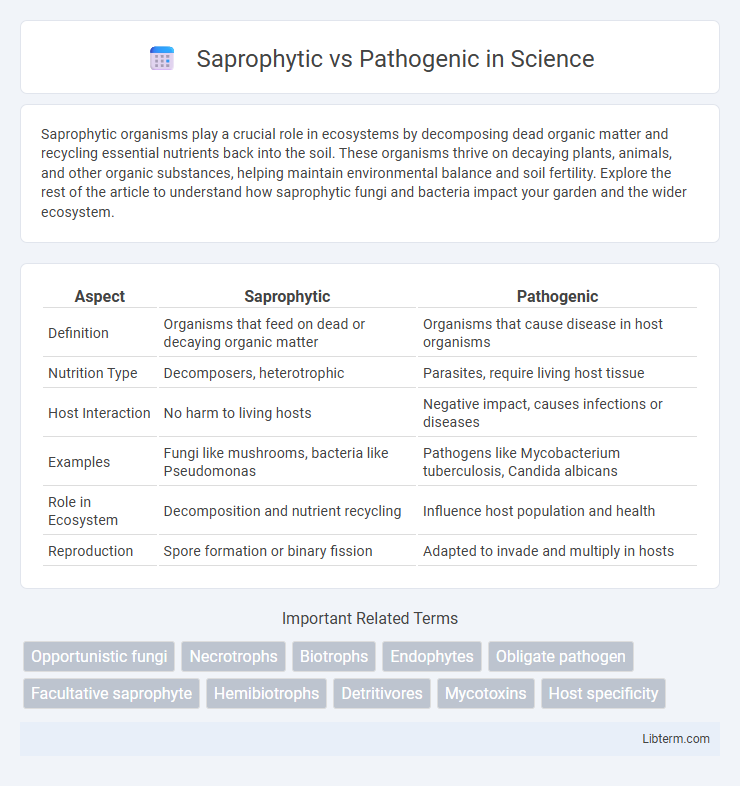Saprophytic organisms play a crucial role in ecosystems by decomposing dead organic matter and recycling essential nutrients back into the soil. These organisms thrive on decaying plants, animals, and other organic substances, helping maintain environmental balance and soil fertility. Explore the rest of the article to understand how saprophytic fungi and bacteria impact your garden and the wider ecosystem.
Table of Comparison
| Aspect | Saprophytic | Pathogenic |
|---|---|---|
| Definition | Organisms that feed on dead or decaying organic matter | Organisms that cause disease in host organisms |
| Nutrition Type | Decomposers, heterotrophic | Parasites, require living host tissue |
| Host Interaction | No harm to living hosts | Negative impact, causes infections or diseases |
| Examples | Fungi like mushrooms, bacteria like Pseudomonas | Pathogens like Mycobacterium tuberculosis, Candida albicans |
| Role in Ecosystem | Decomposition and nutrient recycling | Influence host population and health |
| Reproduction | Spore formation or binary fission | Adapted to invade and multiply in hosts |
Introduction to Saprophytic and Pathogenic Organisms
Saprophytic organisms obtain nutrients by decomposing dead organic matter, playing a vital role in nutrient cycling and ecosystem balance. Pathogenic organisms cause diseases in hosts by invading tissues and disrupting normal biological functions, often leading to infection and illness. Understanding the differences between saprophytic and pathogenic organisms is crucial for fields like microbiology, agriculture, and medicine.
Defining Saprophytic Organisms
Saprophytic organisms obtain nutrients by decomposing dead organic matter, playing a crucial role in nutrient cycling and soil fertility. These organisms, primarily fungi and bacteria, secrete enzymes to break down complex organic compounds into simpler substances absorbable by their cells. Unlike pathogenic organisms that cause diseases in living hosts, saprophytes contribute to ecosystem stability by recycling nutrients and preventing accumulation of organic waste.
Characteristics of Pathogenic Organisms
Pathogenic organisms possess specialized virulence factors enabling them to invade host tissues, evade immune responses, and obtain nutrients from living hosts, often causing disease. These microorganisms exhibit adaptability to diverse host environments, demonstrating mechanisms such as toxin production, adhesion to host cells, and immune system suppression. Unlike saprophytes that decompose dead organic matter, pathogenic bacteria, viruses, fungi, or protozoa actively infect and damage living organisms, resulting in symptomatic infections.
Ecological Roles of Saprophytes
Saprophytes play a crucial ecological role by decomposing dead organic matter, recycling nutrients back into ecosystems and maintaining soil health. Unlike pathogenic organisms that cause diseases in hosts, saprophytes derive energy from non-living organic substrates, supporting nutrient cycles essential for plant growth. Their activity enhances carbon cycling and reduces organic waste accumulation, fostering balanced ecosystem functioning.
Mechanisms of Pathogenicity
Pathogenic organisms deploy specialized mechanisms of pathogenicity such as toxin production, adhesion factors, and immune system evasion to infect hosts and cause disease. Saprophytic organisms primarily decompose dead organic matter and lack virulence factors required for host invasion. Understanding the molecular pathways of pathogenicity, including secretion systems and enzyme activity, enhances insight into host-pathogen interactions and disease progression.
Key Differences Between Saprophytes and Pathogens
Saprophytes obtain nutrients by decomposing dead organic matter, playing a crucial role in nutrient recycling and ecosystem sustainability, whereas pathogens invade living hosts causing diseases and disrupting normal biological functions. Unlike saprophytes, which are generally non-harmful and beneficial, pathogens possess virulence factors that enable infection and immune evasion. Key differences include their relationship with the host, impact on health, and modes of nutrient acquisition, highlighting saprophytes' ecological importance and pathogens' disease-causing potential.
Examples of Common Saprophytic Species
Saprophytic organisms, such as Aspergillus niger, Penicillium chrysogenum, and Rhizopus stolonifer, obtain nutrients by decomposing dead organic matter, playing a crucial role in nutrient cycling and ecosystem balance. In contrast, pathogenic species like Staphylococcus aureus and Candida albicans cause diseases by infecting living hosts, often triggering immune responses. Understanding these differences highlights the ecological importance of saprophytes versus the medical relevance of pathogens in environmental and health contexts.
Notable Pathogenic Microorganisms
Notable pathogenic microorganisms include bacteria like *Mycobacterium tuberculosis*, fungi such as *Candida albicans*, and viruses like the influenza virus, all of which can cause diseases in humans and animals. Unlike saprophytic organisms that feed on dead organic matter, pathogenic microbes invade living hosts, triggering infections and immune responses. Understanding the specific pathogenic mechanisms of these microorganisms aids in developing targeted treatments and preventive measures.
Impact on Human Health and Environment
Saprophytic organisms decompose dead organic matter, recycling nutrients and supporting ecosystem health without harming humans. Pathogenic organisms cause diseases in humans, animals, and plants by invading tissues and disrupting normal functions, often leading to widespread health crises. Environmental impact differs as saprophytes promote soil fertility, whereas pathogens can reduce biodiversity and crop yields by inducing infections.
Strategies for Managing Pathogenic Threats
Strategies for managing pathogenic threats focus on early detection through advanced diagnostic tools and implementing targeted treatments such as antibiotics or antifungals. Environmental control measures, including sanitation, sterilization, and waste management, limit pathogen proliferation while promoting the growth of non-harmful saprophytic organisms. Enhancing host immunity via vaccination and biocontrol agents further reduces pathogenic impact in agricultural and clinical settings.
Saprophytic Infographic

 libterm.com
libterm.com